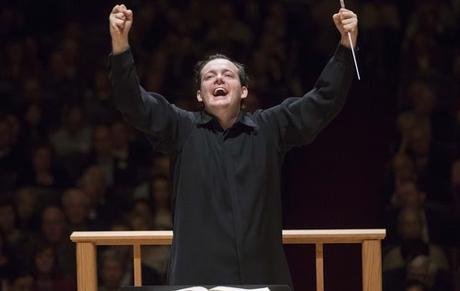by Paul J. Pelkonen

Andris Nelsons in flight.
Photo by Marco Borggreve for the Boston Symphony Orchestra.
The concert opened in the twentieth century with a work by Gunther Schuller. Schuller, who died in 2015 was a leading light among Boston composers. He was the former head of the New England Conservatory and a progenitor of the "third stream," a wide-ranging movement of musicians and composers that attempted to merge the schools of European modern music and jazz, an idea that grew out of his work with arranger Gil Evans and trumpeter Miles Davis
Schuller's Seven Studies on Themes of Paul Klee is an early work and one of his best known. Written in 1959 as its creator embarked on a compositional career, it shows Schuller attempting to break the conventions of serialism with a series of depictions of Klee's visual art. The opening "Ancient Village" was a prickly, at times thorny movement that challenged wind players and listeners alike.
The second movement, "Abstract Trio" is just what it sounds like, using tone-rows to create webs of wind and brass with interjections from the strings. Of these musical sketches, the third, "Little Blue Devil" was the most memorable, with a plucked double-bass solo that set toes tapping both in the audience and in the wind section. The remaining movements alternated between twelve-tone ideas, blues scales and swing rhythms, ending with the upbeat "Pastorale."
Mozart's Piano Concerto No. 22 is one of the composer's most evergreen, and pianist Emanual Ax proved to be a good natured and welcome collaborator in its three movements. Mr. Ax also displayed a sense of humor in the first movement, tossing in a snatch of the theme from the fourth movement of Beethoven's Eroica, the work that would make up the second half of the evening.
Beethoven is sacred to the musicians of the BSO, and the composer's name is stamped on a cartouche high above the stage of Symphony Hall, the only composer to have that honor. The musicians played the Eroica Symphony with a rude vitality, with the wind and horn solos in the first movement interjecting themselves between the relentless, repeated rhythms. The great funeral march was played at a slow and solemn tempo, with the horns wailing in grief in their solo passages.
The third movement was a release of tension, its whirling rhythms lifting the listener out of the despair of the Marcia Funebre. The trio section had a bold energy, with crisp strings supporting the raw sound of the horns. And then that magnificent final steeplechase, with the plucked opening theme building in complexity and involvement to make way for the great sounding of the final theme and the sound of Beethoven conquering his own demons and with Mr. Nelsons' help, putting them to temporary rest.

